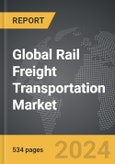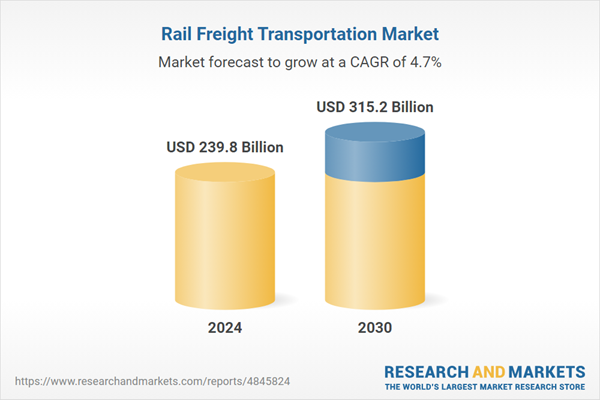The global market for Rail Freight Transportation was valued at US$239.8 Billion in 2024 and is projected to reach US$315.2 Billion by 2030, growing at a CAGR of 4.7% from 2024 to 2030. This comprehensive report provides an in-depth analysis of market trends, drivers, and forecasts, helping you make informed business decisions. The report includes the most recent global tariff developments and how they impact the Rail Freight Transportation market.
Advancements in rail freight technology and infrastructure have significantly improved the efficiency, reliability, and sustainability of rail transportation. Innovations such as automated train operations, advanced signaling systems, and real-time tracking have increased the operational efficiency and safety of rail networks. Modern locomotives equipped with energy-efficient engines and hybrid technologies reduce fuel consumption and greenhouse gas emissions, aligning with global sustainability goals. Additionally, the development of high-capacity wagons and double-stack container trains has maximized the utilization of rail infrastructure, allowing for the transportation of larger volumes of goods in a single trip. Investments in rail infrastructure, including the expansion of rail networks and the enhancement of intermodal facilities, have further bolstered the capacity and connectivity of rail freight services.
The growth in the rail freight transportation market is driven by several factors. One of the primary drivers is the increasing globalization of trade, which has heightened the demand for efficient and reliable long-distance transportation solutions. With congestion becoming a major issue with road freight transportation, businesses are increasingly turning towards rail freight transportation. The rising emphasis on environmental sustainability has also played a crucial role, as rail freight offers a greener alternative to road and air transport, producing lower carbon emissions per ton-mile. Economic growth in emerging markets, particularly in Asia and Africa, has spurred investments in rail infrastructure, boosting the capacity and reach of rail networks in these regions. Technological advancements, including the adoption of big data analytics and the Internet of Things (IoT), have enhanced the efficiency and transparency of rail freight operations, making them more attractive to shippers. Additionally, government policies and incentives promoting rail transport, coupled with increased investments from private sector players, have further accelerated the expansion and modernization of rail freight services. The growing need for reliable and scalable logistics solutions in industries such as e-commerce, manufacturing, and energy continues to drive the demand for rail freight transportation.
Segments: Type (Intermodals, Freight Cars, Tank Wagons); End-Use (Oil & Gas, Mining, Chemical, Transport, Other End-Uses).
Geographic Regions/Countries: World; USA; Canada; Japan; China; Europe; France; Germany; Italy; UK; Spain; Russia; Rest of Europe; Asia-Pacific; Australia; India; South Korea; Rest of Asia-Pacific; Latin America; Argentina; Brazil; Mexico; Rest of Latin America; Middle East; Iran; Israel; Saudi Arabia; UAE; Rest of Middle East; Africa.
The analysts continuously track trade developments worldwide, drawing insights from leading global economists and over 200 industry and policy institutions, including think tanks, trade organizations, and national economic advisory bodies. This intelligence is integrated into forecasting models to provide timely, data-driven analysis of emerging risks and opportunities.
Global Rail Freight Transportation Market - Key Trends & Drivers Summarized
Rail freight transportation is a critical component of the global logistics network, offering an efficient and cost-effective means of moving large volumes of goods over long distances. This mode of transport is particularly advantageous for heavy and bulky items, such as coal, minerals, chemicals, and automotive products, which can be challenging and expensive to transport via road or air. Rail freight systems are designed to handle a variety of cargo types, including containerized goods, bulk commodities, and specialized freight like hazardous materials. The extensive rail networks in regions such as North America, Europe, and Asia enable seamless integration with other transport modes, including ships and trucks, facilitating multimodal logistics solutions that enhance the efficiency of supply chains.Advancements in rail freight technology and infrastructure have significantly improved the efficiency, reliability, and sustainability of rail transportation. Innovations such as automated train operations, advanced signaling systems, and real-time tracking have increased the operational efficiency and safety of rail networks. Modern locomotives equipped with energy-efficient engines and hybrid technologies reduce fuel consumption and greenhouse gas emissions, aligning with global sustainability goals. Additionally, the development of high-capacity wagons and double-stack container trains has maximized the utilization of rail infrastructure, allowing for the transportation of larger volumes of goods in a single trip. Investments in rail infrastructure, including the expansion of rail networks and the enhancement of intermodal facilities, have further bolstered the capacity and connectivity of rail freight services.
The growth in the rail freight transportation market is driven by several factors. One of the primary drivers is the increasing globalization of trade, which has heightened the demand for efficient and reliable long-distance transportation solutions. With congestion becoming a major issue with road freight transportation, businesses are increasingly turning towards rail freight transportation. The rising emphasis on environmental sustainability has also played a crucial role, as rail freight offers a greener alternative to road and air transport, producing lower carbon emissions per ton-mile. Economic growth in emerging markets, particularly in Asia and Africa, has spurred investments in rail infrastructure, boosting the capacity and reach of rail networks in these regions. Technological advancements, including the adoption of big data analytics and the Internet of Things (IoT), have enhanced the efficiency and transparency of rail freight operations, making them more attractive to shippers. Additionally, government policies and incentives promoting rail transport, coupled with increased investments from private sector players, have further accelerated the expansion and modernization of rail freight services. The growing need for reliable and scalable logistics solutions in industries such as e-commerce, manufacturing, and energy continues to drive the demand for rail freight transportation.
Report Scope
The report analyzes the Rail Freight Transportation market, presented in terms of units. The analysis covers the key segments and geographic regions outlined below.Segments: Type (Intermodals, Freight Cars, Tank Wagons); End-Use (Oil & Gas, Mining, Chemical, Transport, Other End-Uses).
Geographic Regions/Countries: World; USA; Canada; Japan; China; Europe; France; Germany; Italy; UK; Spain; Russia; Rest of Europe; Asia-Pacific; Australia; India; South Korea; Rest of Asia-Pacific; Latin America; Argentina; Brazil; Mexico; Rest of Latin America; Middle East; Iran; Israel; Saudi Arabia; UAE; Rest of Middle East; Africa.
Key Insights:
- Market Growth: Understand the significant growth trajectory of the Intermodals segment, which is expected to reach US$137.9 Billion by 2030 with a CAGR of a 4.1%. The Freight Cars segment is also set to grow at 4.8% CAGR over the analysis period.
- Regional Analysis: Gain insights into the U.S. market, valued at $78.1 Billion in 2024, and China, forecasted to grow at an impressive 6.1% CAGR to reach $42.8 Billion by 2030. Discover growth trends in other key regions, including Japan, Canada, Germany, and the Asia-Pacific.
Why You Should Buy This Report:
- Detailed Market Analysis: Access a thorough analysis of the Global Rail Freight Transportation Market, covering all major geographic regions and market segments.
- Competitive Insights: Get an overview of the competitive landscape, including the market presence of major players across different geographies.
- Future Trends and Drivers: Understand the key trends and drivers shaping the future of the Global Rail Freight Transportation Market.
- Actionable Insights: Benefit from actionable insights that can help you identify new revenue opportunities and make strategic business decisions.
Key Questions Answered:
- How is the Global Rail Freight Transportation Market expected to evolve by 2030?
- What are the main drivers and restraints affecting the market?
- Which market segments will grow the most over the forecast period?
- How will market shares for different regions and segments change by 2030?
- Who are the leading players in the market, and what are their prospects?
Report Features:
- Comprehensive Market Data: Independent analysis of annual sales and market forecasts in US$ Million from 2024 to 2030.
- In-Depth Regional Analysis: Detailed insights into key markets, including the U.S., China, Japan, Canada, Europe, Asia-Pacific, Latin America, Middle East, and Africa.
- Company Profiles: Coverage of players such as APC Asia Pacific Cargo (S) Pte Ltd, Baxter Freight Limited, Arshiya Ltd., Baltic Rail AS, 88 Transportation and more.
- Complimentary Updates: Receive free report updates for one year to keep you informed of the latest market developments.
Some of the 127 companies featured in this Rail Freight Transportation market report include:
- APC Asia Pacific Cargo (S) Pte Ltd
- Baxter Freight Limited
- Arshiya Ltd.
- Baltic Rail AS
- 88 Transportation
- ACFS Port Logistics
- Addways Logistics, JSC
- Arc Infrastructure Pty Ltd.
- Arkas Logistics
- Associated British Ports
- Be Accurate Ltd.
- Assured Group Ltd
- 4PX WorldWide Express
- ANL Singapore Pte. Limited
- Aurizon Holdings Ltd.
Tariff Impact Analysis: Key Insights for 2025
Global tariff negotiations across 180+ countries are reshaping supply chains, costs, and competitiveness. This report reflects the latest developments as of April 2025 and incorporates forward-looking insights into the market outlook.The analysts continuously track trade developments worldwide, drawing insights from leading global economists and over 200 industry and policy institutions, including think tanks, trade organizations, and national economic advisory bodies. This intelligence is integrated into forecasting models to provide timely, data-driven analysis of emerging risks and opportunities.
What’s Included in This Edition:
- Tariff-adjusted market forecasts by region and segment
- Analysis of cost and supply chain implications by sourcing and trade exposure
- Strategic insights into geographic shifts
Buyers receive a free July 2025 update with:
- Finalized tariff impacts and new trade agreement effects
- Updated projections reflecting global sourcing and cost shifts
- Expanded country-specific coverage across the industry
Table of Contents
I. METHODOLOGYMII. EXECUTIVE SUMMARY2. FOCUS ON SELECT PLAYERSIII. MARKET ANALYSISCANADAITALYSPAINRUSSIAREST OF EUROPESOUTH KOREAREST OF ASIA-PACIFICARGENTINABRAZILMEXICOREST OF LATIN AMERICAIRANISRAELSAUDI ARABIAUNITED ARAB EMIRATESREST OF MIDDLE EASTIV. COMPETITION
1. MARKET OVERVIEW
3. MARKET TRENDS & DRIVERS
4. GLOBAL MARKET PERSPECTIVE
UNITED STATES
JAPAN
CHINA
EUROPE
FRANCE
GERMANY
UNITED KINGDOM
ASIA-PACIFIC
AUSTRALIA
INDIA
LATIN AMERICA
MIDDLE EAST
AFRICA
Companies Mentioned (Partial List)
A selection of companies mentioned in this report includes, but is not limited to:
- APC Asia Pacific Cargo (S) Pte Ltd
- Baxter Freight Limited
- Arshiya Ltd.
- Baltic Rail AS
- 88 Transportation
- ACFS Port Logistics
- Addways Logistics, JSC
- Arc Infrastructure Pty Ltd.
- Arkas Logistics
- Associated British Ports
- Be Accurate Ltd.
- Assured Group Ltd
- 4PX WorldWide Express
- ANL Singapore Pte. Limited
- Aurizon Holdings Ltd.
Table Information
| Report Attribute | Details |
|---|---|
| No. of Pages | 534 |
| Published | April 2025 |
| Forecast Period | 2024 - 2030 |
| Estimated Market Value ( USD | $ 239.8 Billion |
| Forecasted Market Value ( USD | $ 315.2 Billion |
| Compound Annual Growth Rate | 4.7% |
| Regions Covered | Global |









